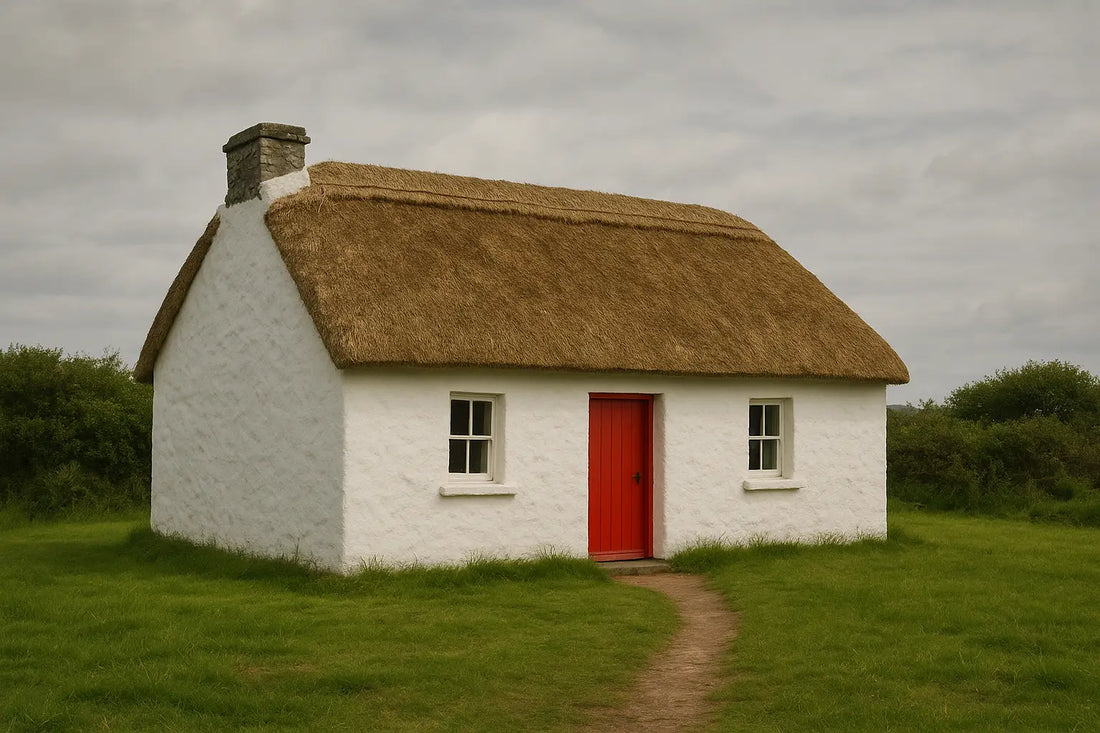
Le charme et les origines des cottages irlandais
Partager
Les cottages irlandais comptent parmi les symboles les plus emblématiques du paysage rural irlandais. Leurs pittoresques murs blanchis à la chaux, leurs épais toits de chaume et leurs portes souvent d'un rouge éclatant fascinent depuis des siècles. Mais au-delà de leur apparence idyllique, ces cottages recèlent une histoire culturelle et historique riche, profondément ancrée dans le patrimoine irlandais.
Les origines
La chaumière irlandaise traditionnelle, ou teachín en irlandais, est apparue comme une solution pratique aux conditions de vie rurales en Irlande à partir du XVIIe siècle. Ces chaumières étaient généralement construites par des fermiers locataires ou de petits exploitants agricoles à l'aide de matériaux locaux et facilement disponibles. La pierre, la terre et le bois constituaient la structure, tandis que le chaume, fait de roseaux locaux ou de paille, servait de toiture.
Les premiers cottages irlandais étaient des habitations simples, d'une ou deux pièces, conçues pour optimiser le confort thermique et l'efficacité énergétique. Construits bas et dotés de murs épais, ils étaient parfaitement adaptés au climat humide et venteux de l'Irlande. Souvent, un foyer central, alimenté par la tourbe des tourbières environnantes, constituait le cœur de la maison et servait à la fois à la cuisson et au chauffage.
Pourquoi ce blanchiment ?
L'une des caractéristiques les plus reconnaissables du cottage irlandais est sa façade d'un blanc éclatant. Ce résultat était obtenu par le blanchiment à la chaux, un choix à la fois pratique et esthétique qui répondait à plusieurs objectifs :
Protection : La chaux, à base de chaux, offrait un revêtement antibactérien naturel, contribuant à protéger contre l'humidité et les infestations d'insectes.
Accessibilité financière : La chaux était bon marché et largement disponible en Irlande, ce qui en faisait un matériau accessible aux communautés rurales.
Fraîcheur : Traditionnellement, les cottages étaient blanchis à la chaux chaque année, surtout avant Pâques, afin de « rafraîchir » la maison et de lui donner un aspect propre et lumineux.
La façade blanche offrait non seulement des avantages pratiques, mais permettait également aux cottages de se démarquer dans la campagne verdoyante d'Irlande, ajoutant ainsi à leur charme visuel.
L'utilité des toits de chaume
Les toits de chaume sont sans doute l'élément le plus caractéristique de la silhouette des cottages irlandais. Le chaume était non seulement une solution de couverture économique, mais aussi un matériau renouvelable et local. Les fermiers couvraient souvent eux-mêmes leurs toits en utilisant :
Roseau aquatique dans les régions plus humides
Paille issue de cultures locales
Des joncs ou de la bruyère dans certaines zones
Le chaume offrait une excellente isolation, maintenant les chaumières chaudes en hiver et fraîches en été. Cependant, les toits de chaume nécessitaient un entretien régulier et devaient être refaits ou réparés tous les deux ou trois ans, ce qui a progressivement entraîné leur déclin avec l'arrivée de matériaux plus modernes.
L'histoire derrière la porte rouge
Les portes rouges des cottages irlandais, peintes de couleurs vives, suscitent depuis longtemps la curiosité et alimentent les légendes locales. Voici quelques explications traditionnelles de cette caractéristique colorée :
Protection symbolique : Certains croyaient que peindre une porte en rouge permettait d’éloigner les mauvais esprits et la malchance.
Signification religieuse : Dans certaines communautés catholiques, le rouge était perçu comme un symbole de protection, rappelant l’histoire biblique de la Pâque.
Aspect pratique : La peinture rouge, souvent fabriquée à partir de pigments naturels mélangés à du sang animal ou à de l'oxyde de fer, était durable et facilement disponible.
Plus récemment, la porte rouge est également devenue un symbole de fierté et d'individualité, les propriétaires choisissant des couleurs vives pour personnaliser leurs maisons.
Les cottages irlandais sont bien plus que de charmantes maisons de campagne ; ils témoignent de l’histoire, de la résilience et de la culture irlandaises. Leurs murs blanchis à la chaux, leurs toits de chaume et leurs portes rouges racontent une histoire de praticité, de tradition et d’un lien profond avec la terre. Aujourd’hui, nombre de ces cottages ont été préservés ou restaurés avec soin, devenant ainsi des symboles durables de la campagne irlandaise.
Si jamais vous vous promenez sur les routes côtières ou les collines verdoyantes d'Irlande, la vue d'un de ces cottages pourrait bien vous transporter dans le temps, à une époque où la vie était plus simple et plus paisible. Mieux encore, séjournez dans l'un de nos cottages irlandais traditionnels, fidèlement reconstitués, et allumez un feu de tourbe pour une immersion totale dans l'histoire.
